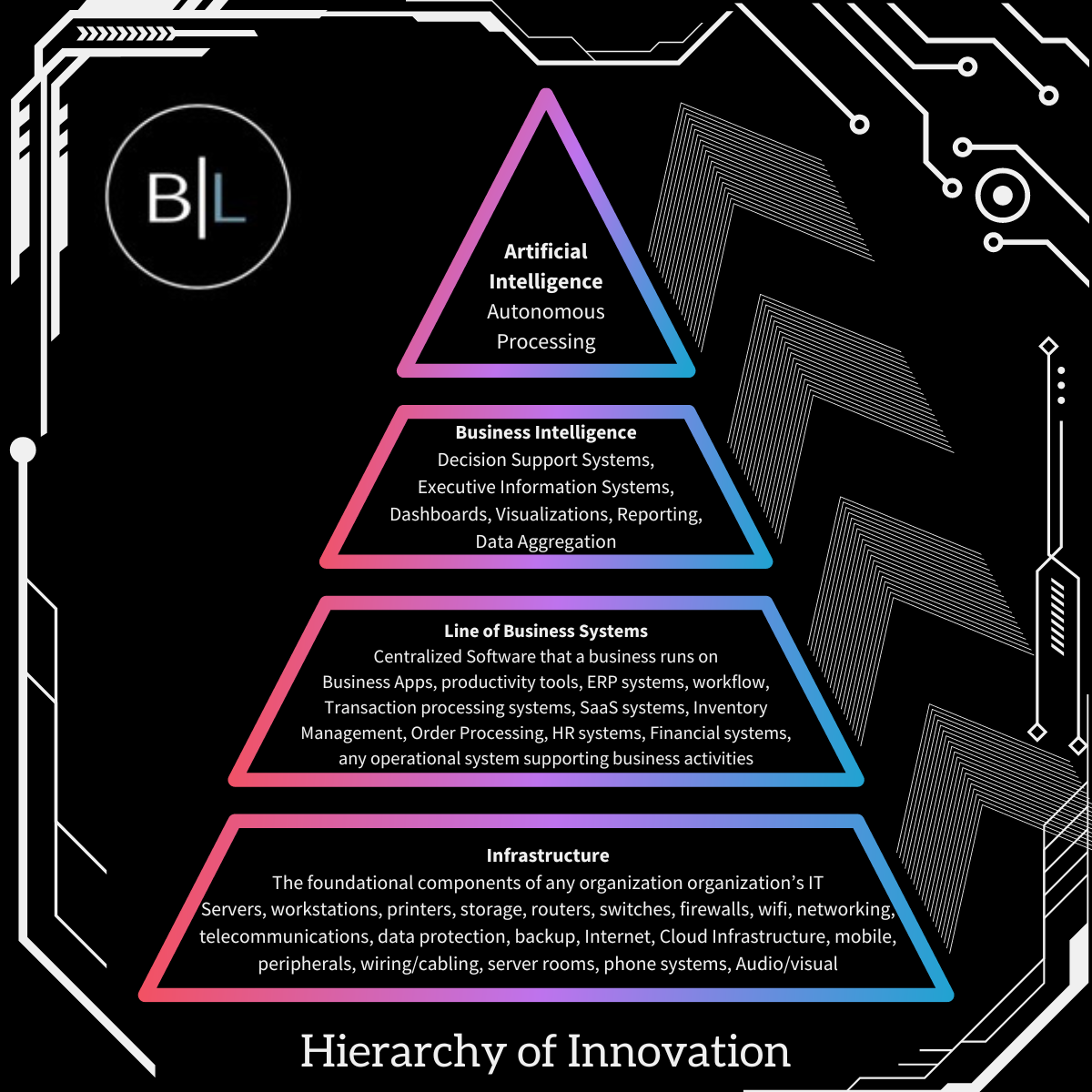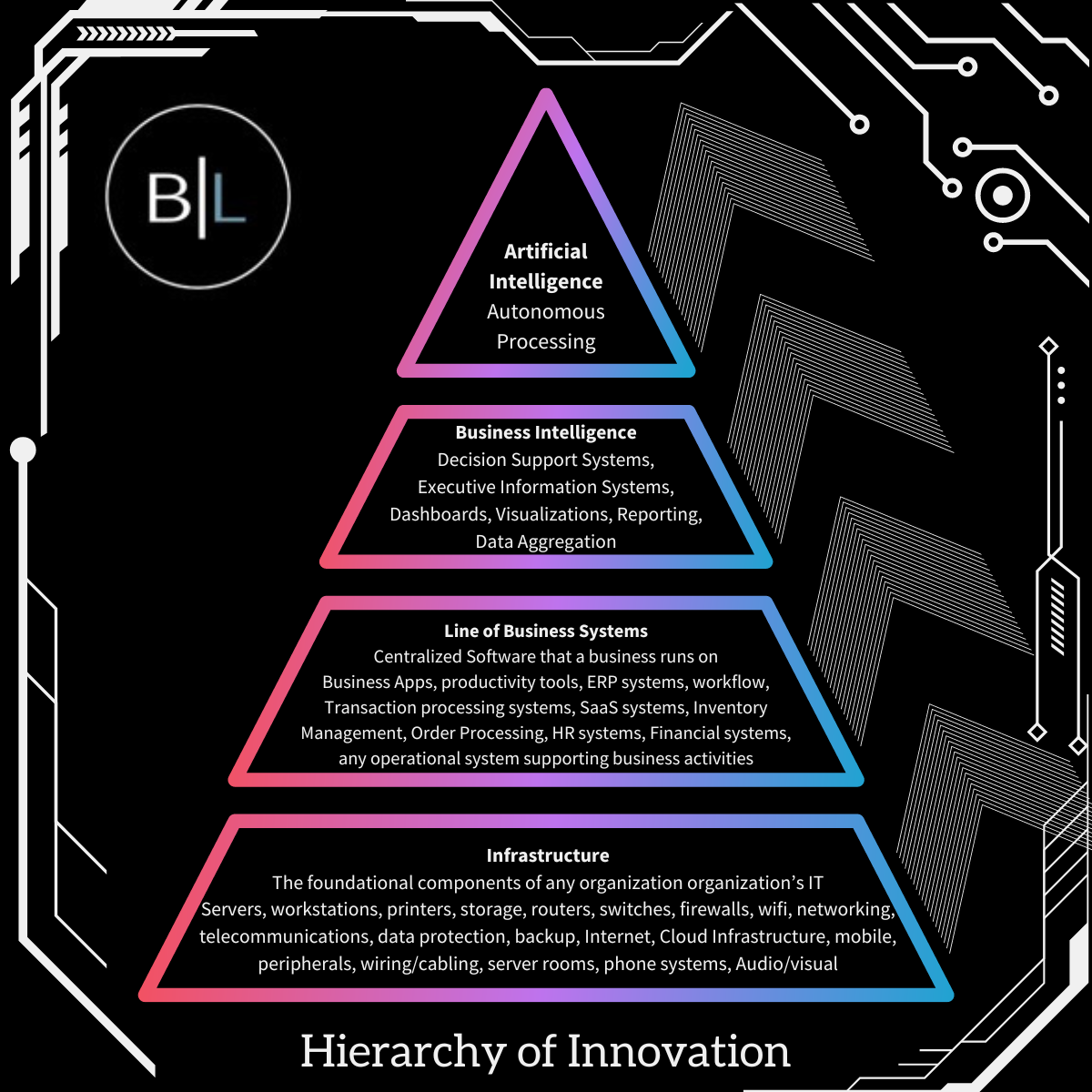Introduction
Innovation is the lifeblood of modern businesses. As markets evolve and consumer demands shift, companies that adapt and embrace new technologies and strategies are the ones that thrive.
After 40 years of serving the IT needs of small and mid-sized businesses, Black Line has developed the "Hierarchy of Innovation" to explain the various components of Information Technology and how they interact and depend on each other. Black Line's Hierarchy of Innovation was intended to educate Business Leaders to help them prioritize their Information Technology decisions by visualizing the solutions they want in relation to the supporting technologies needed to get them there.
In this blog post, we'll guide you through Black Line’s Hierarchy of Innovation and demonstrate its significance for business owners, entrepreneurs, and creators who want to stay competitive in today's rapidly changing landscape.
In the following sections, we will break down the Hierarchy of Innovation into its essential components and share insights on implementing them within your organization effectively. By understanding and embracing this framework, you'll be better equipped to identify opportunities for innovation, develop a strategic plan, and unlock your business's full potential. So let's dive in and explore the Hierarchy of Innovation together.
The Hierarchy of Innovation: A Comprehensive Breakdown

The hierarchy of innovation is a structured framework that outlines the different layers of the business's technological components to achieve scalability, adaptability, and efficiency, ultimately leading to growth. Businesses, creators, and entrepreneurs can prioritize and strategize their innovation efforts by understanding and embracing each level of the hierarchy. The hierarchy consists of four primary levels:
- Infrastructure: The foundation of any organization's IT, including servers, workstations, networks, and cloud infrastructure, enables all other layers to function effectively.
- Line of Business Systems: Centralized software and tools that support business activities, such as ERP systems, workflow management, HR systems, and financial systems.
- Business Intelligence: Decision support systems, data aggregation, dashboards, and visualizations that help businesses analyze and make data-driven decisions.
- Artificial Intelligence: The highest level of innovation where autonomous processing, machine learning, and advanced algorithms are leveraged to enhance business processes, products, and services.
By investing in each layer of the hierarchy, organizations can ensure they are maximizing their potential, making better use of available resources, and delivering superior value to their customers. Moreover, the hierarchy of innovation acts as a guide for identifying and prioritizing improvement areas, helping businesses focus their efforts on what matters most and driving innovation across the entire organization.
Infrastructure: The Foundation for Innovation

The importance of a robust IT infrastructure cannot be overstated. As the first and most fundamental level of the Hierarchy of Innovation, a solid IT infrastructure is the backbone for all technological initiatives in your business. A well-designed infrastructure allows for seamless communication, collaboration, and data management, enabling you to focus on core business operations without technical limitations.
Critical components of an adequate IT infrastructure include servers, workstations, printers, storage, routers, switches, firewalls, Wi-Fi, networking, telecommunications, data protection, backup, Internet, Cloud Infrastructure, mobile devices, peripherals, wiring/cabling, server rooms, phone systems, and audio/visual equipment.
Ensuring compatibility, scalability, and reliability across all components is crucial for fostering innovation.
To build a robust IT infrastructure, start by assessing your current infrastructure and identifying areas for improvement or expansion. Develop a strategic plan for upgrading or implementing new technologies, keeping your specific business needs and goals in mind. Work with trusted partners, like Black Line IT, or in-house IT teams to execute the plan and ensure a smooth transition. This will provide a solid foundation for your business to innovate and grow.
Line of Business Systems: Streamlining Business Operations
-1.png?width=421&height=133&name=Untitled%20(1)-1.png)
Line of Business Systems plays a crucial role in the Hierarchy of Innovation, as they are centralized software and tools that support various aspects of your company's operations. These systems bridge your IT infrastructure and higher-level innovation processes, enabling your business to run efficiently and effectively.
Examples of Line of Business Systems include business apps, productivity tools, ERP systems, workflow management, transaction processing systems, SaaS systems, inventory management, order processing, HR systems, financial systems, and other operating systems supporting business activities. These systems allow businesses to automate and optimize their core processes, freeing up resources to focus on innovation and growth.
To choose the suitable Line of Business Systems for your company, start by evaluating your company's specific needs, pain points, and goals. Research and compare various solutions available in the market, considering factors like scalability, ease of use, integration capabilities, and cost. Seek expert advice or consult with your IT team to ensure the chosen systems align with your business objectives and IT infrastructure. This will help you maximize the benefits of your Line of Business Systems and support your company's growth and innovation.
Business Intelligence: Turning Data into Actionable Insights
-1.png?width=421&height=133&name=Untitled%20(1)-1.png)
Business Intelligence (BI) is a vital component of the Hierarchy of Innovation, as it involves using technology to analyze and visualize data, enabling businesses to make informed decisions. BI is essential for organizations to stay competitive, as it helps uncover hidden opportunities, identify trends, and improve overall performance.
Critical components of Business Intelligence include Decision Support Systems (DSS) and Executive Information Systems (EIS), which aid in decision-making by providing insights and recommendations based on data analysis. Dashboards and visualizations offer an easy-to-understand representation of data, allowing stakeholders to identify patterns and trends quickly. Reporting and data aggregation tools compile data from various sources, making it accessible and useful for decision-making.
To effectively implement Business Intelligence in your organization, assess your current data sources and infrastructure to ensure they can support BI initiatives. Develop a BI strategy that aligns with your organization's goals and objectives. Choose appropriate BI tools and technologies, considering factors like ease of use, scalability, and integration capabilities. Lastly, train your team in data analysis and visualization techniques to maximize the value of the BI system. Doing so will strengthen your organization's decision-making capabilities and drive innovation.
Artificial Intelligence: Pioneering the Future of Innovation
.png?width=201&height=194&name=Untitled%20(3).png)
Artificial Intelligence (AI) is the pinnacle of the Hierarchy of Innovation, as it involves leveraging advanced algorithms, machine learning, and automation to perform tasks and make decisions without human intervention. AI has the potential to revolutionize industries, streamline processes, and create new opportunities for growth and innovation.
Key aspects of Artificial Intelligence include Machine Learning (ML), which allows systems to learn from data and improve their performance over time. Natural Language Processing (NLP) helps computers understand and process human language, enabling more effective communication between humans and machines. Computer Vision allows devices to recognize and interpret visual information, which can be used for object identification, facial recognition, and image analysis. Robotics and automation involve using AI-powered machines to perform tasks, often with greater efficiency and precision than humans.
To implement Artificial Intelligence in your organization, identify areas where AI can significantly impact your business, such as improving customer service, optimizing operations, or enhancing product development. Develop a clear AI strategy that considers ethical implications, data privacy, and workforce implications. Collaborate with AI experts and invest in the necessary resources and infrastructure to support AI initiatives. Lastly, monitor and measure the performance of AI systems to ensure they deliver the desired results and continuously improve over time. Integrating AI into your organization can unlock new possibilities for growth and innovation.
Embracing the Hierarchy of Innovation for Long-term Success
Mastering the Hierarchy of Innovation is crucial for organizations seeking long-lasting success. This blueprint helps businesses, creators, and entrepreneurs identify and organize their IT investments and projects, allowing them to synchronize their technology approach with their objectives and ultimately create a more innovative and competitive enterprise. To craft a holistic technology plan, organizations must evaluate their present standing within the Innovation Ladder, pinpoint any shortcomings or opportunities for enhancement, and design an all-encompassing strategy that tackles the needs and prospects identified at each rung of the ladder.
Continuous monitoring and adapting the technology approach is vital to stay in sync with emerging trends and industry advancements. Nurturing an atmosphere of innovation requires advocating for transparent communication and teamwork within the organization, allocating resources to education and skill development, and establishing a work environment that promotes experimentation, learning, and expansion. By acknowledging and adopting the Hierarchy of Innovation, businesses can construct a solid foundation for technology-driven success, maintain flexibility in an increasingly competitive market, and cultivate a culture of continuous innovation that drives long-term growth and prosperity.

